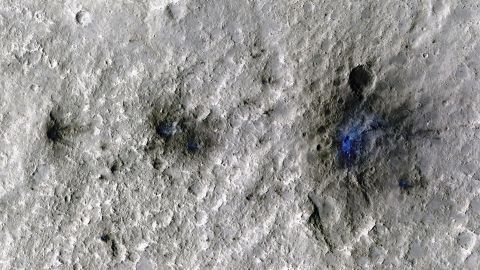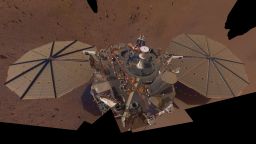Sign up for CNN’s Wonder Theory science newsletter. Explore the universe with news on fascinating discoveries, scientific advancements and more.
The NASA InSight Lander has “heard” and detected the vibrations of four space rocks as they slammed into Mars over the past two years.
It’s the first time a mission has picked up both seismic and acoustic waves from an impact on Mars, and InSight’s first detection of impacts since landing on the red planet in 2018.
Fortunately, InSight wasn’t in the path of these meteoroids, the name for space rocks before they hit the ground. The impacts ranged from 53 to 180 miles (85 to 290 kilometers) away from the stationary lander’s position in Mars’ Elysium Planitia, a smooth plain that’s just north of its equator.

A meteoroid hit the Martian atmosphere on September 5, 2021, and then exploded into at least three shards, each one leaving behind a crater on the red planet’s surface.
The Mars Reconnaissance Orbiter then flew over the site to confirm where the meteoroid landed, spotting three darkened areas. The orbiter’s color imager, the High-Resolution Imaging Science Experiment camera, took detailed close-ups of the craters.
Researchers shared their findings about the new craters in a study that published Monday in the journal Nature Geoscience.
“After three years of InSight waiting to detect an impact, those craters looked beautiful,” said study coauthor Ingrid Daubar, assistant professor of Earth, environmental, and planetary sciences at Brown University in Providence, Rhode Island, in a statement.
Data from InSight also revealed three other similar impacts, one on May 27, 2020, and two additional ones in 2021 on February 18 and August 31.
The agency released a recording of a Martian meteoroid impact Monday. During the clip, listen for a very science fiction-sounding “bloop” three times as the space rock enters the atmosphere, explodes into pieces and hits the surface.
Scientists have actually questioned why more impacts haven’t been detected on Mars because the planet is located next to our solar system’s main asteroid belt, where many space rocks emerge to hit the Martian surface. The Martian atmosphere only has 1% of the thickness of Earth’s atmosphere, meaning that more meteoroids zip through it without disintegrating.
During its time on Mars, InSight has used its seismometer to detect more than 1,300 marsquakes, which take place when the Martian subsurface cracks due to pressure and heat. The sensitive instrument can detect seismic waves that occur thousands of miles away from InSight’s location – but the September 2021 event is the first time scientists used the waves to confirm an impact.
It’s possible the noise of the Martian wind or seasonal changes that occur in the atmosphere hid the additional impacts . Now that researchers understand what an impact’s seismic signature looks like, they expect to find more when they comb through InSight’s data from the last four years.
Seismic waves are helping researchers unlock additional information about the interior of Mars because they change as they move through different material.
The meteoroid impacts create quakes with a magnitude of 2.0 or less. So far, InSight’s largest detected quake was a magnitude 5 event in May.
Impact craters help scientists understand the age of a planet’s surface. Researchers can also determine how many of the craters formed early on in the tumultuous history of the solar system.
“Impacts are the clocks of the solar system,” said lead author Raphael Garcia, academic researcher at the Institut Supérieur de l’Aéronautique et de l’Espace in Toulouse, France, in a statement. “We need to know the impact rate today to estimate the age of different surfaces.”
Studying InSight’s data can provide researchers with a way to analyze the trajectory and size of the shock wave produced when the meteoroid enters the atmosphere as well as once it hits the ground.
“We’re learning more about the impact process itself,” Garcia said. “We can match different sizes of craters to specific seismic and acoustic waves now.”
InSight’s mission is coming to an end as dust builds up on its solar panels and reduces its power. Eventually, the spacecraft will shut down, but the team is unsure of when that will happen.
The most recent readings have suggested it could shut down between this coming October and January 2023.
Until then, the spacecraft still has a chance to add to its research portfolio and stunning collection of discoveries on Mars.
Article From & Read More ( Listen to the sound of space rocks slamming into Mars - CNN )https://ift.tt/nCBfcGl
Science


No comments:
Post a Comment